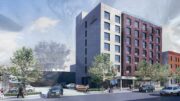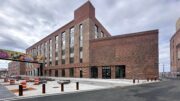In March, during the press conference unveiling Mayor Bill de Blasio’s affordable housing plan, Brooklyn’s new borough president Eric Adams made it clear how he felt about new development: “Build, baby, build. Build tall, build high.”
Taller buildings and denser neighborhoods will be essential if the de Blasio administration is to meet its ambitious affordable housing goals, and Adams has demonstrated his willingness to provide leadership and direction as to where the new housing will go.
Adams is also offering a counter-narrative to those who would seek to keep out new development in the hopes of preventing displacement and gentrification – including many of Brooklyn’s own local council members. “Building higher should not be a curse,” Adams told YIMBY in a recent interview.
His “build, baby, build” comment was a message to developers, Adams said. “There is a need for us to go beyond the boundaries that we have historically looked at for new buildings,” Adams said. “I’m extremely excited about the possibilities of upzoning areas like the Broadway Corridor, between the Williamsburg Bridge and Broadway Junction” – a transit hub at the intersection of Bed-Stuy, Brownsville and East New York. “I’m asking the developers to look at the borough with an artistic eye.”
The blocks on the south side of Broadway, forming northern boundary of Bedford-Stuyvestant, were rezoned in 2012, increasing the allowed residential density by about two-thirds. Under the rezoning, buildings can reach heights up to 100 feet. Adams wants a similar zoning scheme for the blocks on the north side of Broadway and for the stretch to the west of Flushing.
In order to accomplish this, Adams will have to work with the local councilman Antonio Reynoso, who has already expressed his skepticism of new development. Reynoso has spoken in the past of his desire to rezone the area in a way to preserve its low-rise character.
“I think he is a great councilman, I think he’s a good representative for his district,” Adams said of Reynoso. “He has a council [district]-centric vision while I have a borough-wide vision. It is important that we have a borough-wide vision of how we share the resources of the borough in a way that allows all groups to be a part of it.”
Reyonoso’s political sway on land use is greater than that of the borough president, though Adams does have a voice in the process. Ultimately, it is the City Council that has the final say – and council members often defer to the judgment of the local representative – whereas the borough president’s recommendation is only advisory.
The conversation shifted to gentrification. “I was at a meeting in Bed-Stuy, and the tone of the conversation was about gentrification, about how Bed-Stuy is becoming more and more white. And I responded, ‘Bed Stuy doesn’t belong to blacks, just as Sunset Park doesn’t belong to Hispanics and Bay Ridge to Irish. We build great neighborhoods in the hope that people will come.’ ”
“I understand the desire to be nostalgic, but Brooklyn is going to grow whether we like it or not. We should have a voice in how it grows. And that’s why I welcome Antonio and others to talk about what areas we are going to upzone.”
Adams held up the Bloomberg-era Park Slope rezoning as a model. “We protected the inner blocks, we raised buildings on Fourth Avenue. We upzoned there and it was a great trade-off.”
Adams spoke of how building higher and denser was necessary to keep the borough affordable. “Those who are saying ‘no, we don’t want taller buildings’—they need a reality check. If I want my son to be able to live in Brooklyn, I’d better be able to figure out how to build.” Ultimately, by shutting off new development, “The people you think you’re protecting, you’re not going to protect.”
We also spoke about Industry City in Sunset Park. Jamestown properties just acquired the pre-war complex of industrial buildings with hopes of converting them into new commercial space.
Asked whether housing should be a part of the mix, Adams responded, “The local elected are extremely concerned with losing industrial park space.” But, he said, “I think that there’s room to protect the jobs there and at the same time become creative and find some form of housing there.” Adams noted that there was some land “used for parking only,” which could be used as housing.
“We need to create employment opportunities where someone can leave their home, walk down their block, ride their bike down the block or have everything in the same location. That is the goal and Industry City can be a model to accomplish that goal. It’s not going to be an easy task because when people hear of building, immediately bad things come to their mind. And we have to engage in conversations to put some of those fears at bay.”
Is there any hope, then, to forge a consensus on the need for Brooklyn to build up? Or is it always going to be an uphill battle?
“I think that if we start having conversations about the overall plan—the overall plan is to build communities where we can have employment in the same community, and to ensure that whatever benefits that it will benefit that entire neighborhood—I think if we start building the conversation around that, then it’s not about displacement but about ensuring a proper placement.”
Talk about this topic on the YIMBY Forums
For any questions, comments, or feedback, email newyorkyimby@gmail.com
Subscribe to YIMBY’s daily e-mail
Follow YIMBYgram for real-time photo updates
Like YIMBY on Facebook
Follow YIMBY’s Twitter for the latest in YIMBYnews





